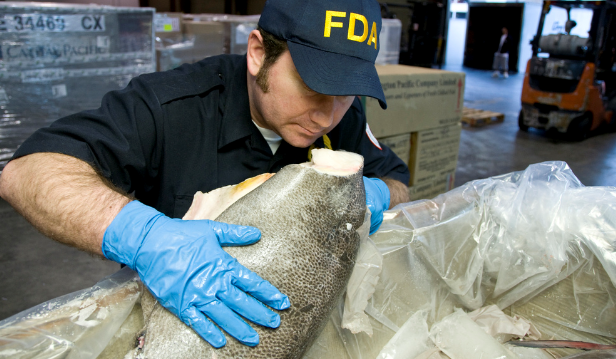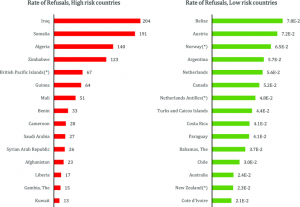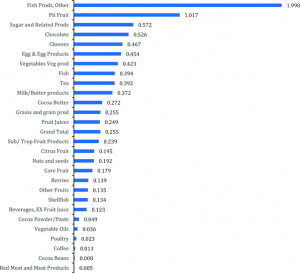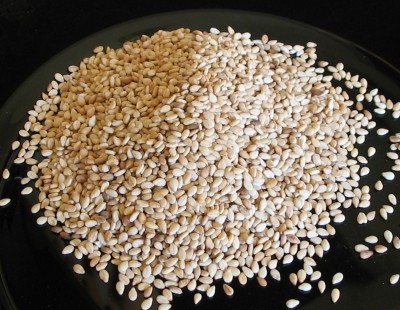Imported food from countries with low GDP poses higher safety risks – study

All of the top 15 import violators were major trading partners of the US; suggesting that the number of refusals is heavily driven by food import volume.
Mexico topped the cumulated refusals from 2002-12, followed by China, India, UK and Canada.
However, after normalizing refusals by volume of imports (measured in millions of dollars) major trading partners were not exclusively identified as the high-risk countries and the list did not include high-income countries.
GDP influence
Jonathan Welburn, of the University of Wisconsin-Madison, Department of Industrial and Systems Engineering, said results suggest the risk level of imported food is higher if from low-GDP countries.
“High-GDP countries, on the other hand, may be better able to reduce risks through standards and regulations. Consequently, importers may wish to pay more for products from high-GDP countries, or work closely with suppliers from low-GDP countries to ensure good safety practices.”
The highest-risk country, Iraq, averaged 204 refusals per million dollars of imports and Somalia averaged 191 refusals per million dollars of imports.
On the lower end of high-risk countries, Gambia averaged 15 refusals per million dollars of imports, and Kuwait 13 refusals per million dollars of imports.
The risk levels for the lowest-risk countries are Belize, which averaged 78 refusals per billion dollars of imports, Austria 72, and New Zealand only 23 per billion dollars of imports.
Researchers used data from 2002-2012 on food import violations from the FDA Operational and Administrative System for Import Support (OASIS) to address concerns with imported food, quantify import risks by product and country of origin, and explore the usefulness of OASIS data for risk assessment.
“The results should be useful to supply-chain managers in determining whether the cost savings associated with a change to a lower cost source country are worthwhile given possible increases in risk, and also in assessing the need for risk-reduction measures such as producer safety training for some product types and source countries.
“Our findings can aid both risk managers and policymakers in understanding import risks and how they might be mitigated.”
To quantify imported food risks, the researchers used FDA Inspection Refusal Report (IRR) data. The agency generates an IRR when its inspectors refuse to admit a shipment into the country.
Annual import refusals have remained within a narrow band from 2002 to 2012, with small variations from year to year while the dollar value of imports has steadily increased.
Indicator of risk
The team recognised the FDA has limited resources to conduct inspections, restricting its ability to capture all import violations, and limiting the representativeness of the data to reflect all risks.
“…data on violations are not a random sample, as the FDA targets certain products, manufacturers, and countries of origin due to past violations or other indications of risk. This, in effect, can lead to higher rates of inspections for certain products and countries than others, which biases the total violation counts.
“We therefore consider import refusal reports to be an indicator rather than an absolute measure of risk.”
They added import violations alone do not fully capture import risks.
“For example, a country that exports a large volume of products may be responsible for numerous import violations even if its risk is small, while a smaller exporter may be responsible for few import violations even if the food exported by that country is of poor quality and safety.
“Therefore… we normalize the number of import violations by the dollar volume of imports, to estimate the rate of refusals associated with any given product type and exporting country.”
High risk foods
Researchers developed an empirical model of risks using statistical regression, taking as independent variables time (year in which an IRR was generated), economic indicators (GDP), and product types.
They found high risk foods included pit fruit, fish products, egg products, citrus fruit, berries, chocolate, tea and milk/butter products.
Certain products (pit fruit, fish products, eggs and egg products, citrus fruit, berries, and chocolate) were found to be relatively high risk, while others (e.g., cocoa beans, poultry, coffee, shellfish, red meat and meat products, and fish) were low risk, at least per dollar volume of imports.
Looking at the differences between chocolate and cocoa beans, or other categories, suggested that processing raw ingredients into complex finished goods in global supply chains may increase the rate of import violations (even if not the rate of serious safety problems).
Considering sugar and related products, the team said: “The overall rate of refusals is high, but after controlling for the effects of GDP and time, sugar and related products actually have a coefficient less than zero. Thus, the risk of sugar imports seems to be driven predominantly by the fact that sugar is generally imported from low-GDP countries.”
Different products showed a different degree of sensitivity to GDP changes. Of three products for 2012, meat appeared to be the most sensitive, grains second and vegetables the least.
“The relatively high sensitivity of meat and meat products to changes in GDP suggests that the increased regulation and infrastructure of high-GDP countries has a more significant impact on risk for meats than for vegetables. Thus, it might make sense to pay a greater premium for meat from high-GDP exporters than for vegetables.”
Fish products showed significantly higher risk than other products, with around two refusals for every million dollars of imports. Citrus fruits, of moderate risk, had just two refusals for every 10 million dollars of imports.
On the low end, cocoa beans averaged just under eight refusals for every billion dollars of imports.
The low rates of FDA refusals for poultry and red meat may not be representative of the overall risks of imports as the vast majority is handled by the Food Safety and Inspection Service (FSIS).
Source: Risk Analysis
Online ahead of print, DOI: 10.1111/risa.12560
“Import Security: Assessing the Risks of Imported Food”
Authors: Jonathan Welburn, Vicki Bier and Steven Hoerning











